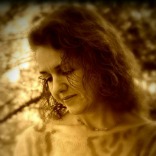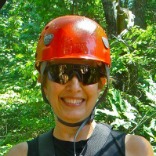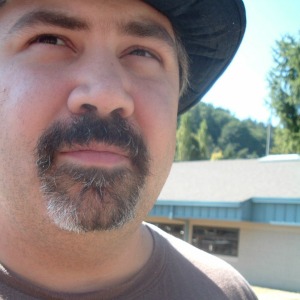Mirage
Leslie Jill Patterson
People in Ouray, Colorado, said they couldn’t survive another winter like 2008. Usually, in the San Juan Mountains, the sun shines 285 days a year, fleecy in winter and razor-edged in summer, but in 2008, record snowfalls smothered the sky and piled snow fifteen feet deep in town where it’s usually only three. Avalanche slides that hadn’t run in almost a century brought down muscular 100-year-old trees. Come that spring, the slopes resembled battlefields, the pines like bodies zigzagged on top of one another and spilling across the highway. The people were bleary-eyed and pale, exhausted from shoveling snow, the weight of chains and snow tires, the millstone of loneliness and peril.
A mere four years later, the winter of 2012 has been dry, merciless in the other extreme. I don’t have a cabin there anymore, and only a few acquaintances, but I watch the news, check weather reports online, hear things. January, they say, was sedate, the “gift” of a mild winter. People went to movies, ate out, drove to neighboring towns at their leisure, a real bed of roses. But by March, winter had failed them altogether, and April barged in feverish as June, triggering the kind of early runoff that foreshadows severe drought.
I’ve seen the consequences of this type of winter before, in 2002, my first year in Colorado. That May, temperatures soared throughout the western United States, humidity levels dropped, the snowpack (shallow like this year’s) melted early, and tourists made grave mistakes. In June, California, Oregon, Washington, Montana, Wyoming, Arizona, New Mexico, and Colorado caught fire. Soon, eight infernos raged in Colorado alone, and one of the worst, The Missionary Ridge Blaze, chugged across the Weminuche Wilderness, a mere sixty-five miles south of Ouray. Every morning, smoke sifted over Red Mountain Pass and filled the town with ash and the exhaust of trees burning. By summer’s end, the local reservoir was so low, so empty, you could drive across it.
I was in Colorado then, taking a vacation from my job as a university professor as well as from my marriage, both my professional and personal lives drought-ridden and ready to go up in flames, too. Every morning, I woke early, wrote till one o’clock, then headed to Eagle Hill Ranch in the valley just north of Ouray. There, I helped a local horse trainer, Billy Scales, by shoveling stalls or hitching a ride on his four-wheeler out to pasture where we nursed a much-needed crop of hay. For whatever reason, the Colorado Division of Water Resources didn’t shut off the valve between Ouray and the Weehawken Spring, the town’s water source, as state law that summer had dictated. Maybe they were too busy handling the wildfires and forgot the draw. And so local ranchers, like Billy, had a small, secret, “illegal” flow they rationed across their pastures.
It wasn’t enough.
That May, when shoots first nudged from the ground, Billy should have scattered a nitrogen fertilizer, as well, but he didn’t have the money. To get just one cutting, he spent three precious hours a day, roaming the land he rented, sinking his spade into the mud and transplanting sod, diverting the flow of water in various directions because he couldn’t afford the pipe system that did the work for you. For those three hours, he wasn’t able to give lessons or train colts—activities that earned him cash.
One afternoon, arriving late, I found Billy at the top of a hill, already at work. He looked like Wilford Brimley: the handlebar mustache, full-moon face, bowling-pin belly that bloated the waistband of his Wranglers, and a copper bracelet, neckerchief and Stetson. The hat cocked upward, and his arms were propped on a shovel as he surveyed his irrigation. Sweat had soaked his shirt.
I parked my car on the gravel road and scrambled over the fence. Billy’s heelers beelined for me, barking, lunging at my hip, splotching my jeans with soppy paw prints. Beneath my boots, the grass squished. Billy wore waders, his jeans tucked inside. Mud spattered his sleeves. A pair of shades dangled from his neck, strong on a Croakie cord.
Billy nodded my direction. “How’s the little professor?”
I smiled in answer. “How’s the hay?”
“Slow,” he said. “With the drought, we won’t reap till August, maybe September.”
I burrowed my boot’s sole into the grass, which was leggy around the irrigation ditches, and marveled at the suction of mud. Less than three feet away, the ground was rigid; the growth, sparse. Billy had told me, a million times, that a cutting late in the summer was problematic.
“August is bad,” I said, so Billy knew I’d been listening.
He nodded. “Tricky.”
In mid-July, the summer normally shifted directions, heading back toward winter. If the drought broke as expected and the monsoon season came, the showers would boost the hay crop but also cool the temperatures, the thermometer dipping into the forties. When a man like Billy can’t afford an inoculant to deter mildew, much less a mechanical swather that both cuts and spreads the grass into windrows, he needs several days of dry, warm weather to harvest. If he bales wet hay, the cut grass continues to generate heat. Later, when he breaks the bales apart for feeding, rot and mold puff in the air as the flakes hit the ground. Bad hay can cause colic—a deadly disease for horses. Even worse, wet bales can warm to 180° and spontaneously combust, catching your barn on fire and charring the livestock inside.
I assumed every rancher in the area would have the same problem. “So there’ll be a shortage of good hay,” I said.
Billy shrugged. “Folks with money and machinery will manage more cuttings. The price will sky-rocket for the rest of us.” He pointed his shovel into the ground, stepped his boot on the spade, and thrust it into the heavy mud, prying it away.
“How much?” I asked.
“Two hundred a ton. I’ll need sixty tons to survive the winter.”
I’d heard stories about ranchers feeding bread loaves and aspen leaves to their winter stock when the summer was barren. The physicist Freeman Dyson once wrote that hay was the most critical invention of the last two millennia: without it, civilization was locked to warmer climates where grass grew in winter and horses could graze year-round. Only in the dark ages, when some anonymous farmer invented hay did civilization move north over the Alps, giving birth to Vienna, Paris, London, eventually New York City.
But Billy couldn’t fret about where society would be without hay. He only knew he couldn’t afford a mower or a baler (he had to borrow them). He knew the men who could buy good machinery—say, a PTO-tractor with a cab and auxiliary hydraulics—would pocket more money that year and get better equipment the next. He knew he’d never catch up.
Still, poor as Billy Scales was, hard as he labored, I’ve never felt richer than those afternoons when he and I rode out to pasture on the four-wheeler, Billy steering, me standing beside him on the running board, his heelers baying at our rear wheels as if herding us. Billy barreled through the irrigation flow, splashing the cool water on our jeans. In the meadow, we listened to the thin riddle of the stream, watched the dogs pounce in the puddles, cut wild asparagus that grew along the creek. Every three days, we worked together to shift the herd of horses to new ground so they wouldn’t scalp their summer food sources. Billy flanked behind them, waving his arms, whistling; I guarded the gate, waiting for them to trample through it, so I could latch it behind them. Because Billy didn’t want me to feel scrawny and useless, he wired a cheater board to the gate so I could crank it, like a crowbar, and lift the wire fence over the latch-post. He and I laughed every time because no matter how hard I wrestled that cheater board, Billy had to finish the job.
“You got to cowgirl up,” he said, laughing. “I never seen a body couldn’t cheat a fence.”
I curled my left bicep and pointed at the pathetic bulb of muscle. “What you need,” I said, “is a friendlier gate.”
I swear, every afternoon, when Billy fired up that four-wheeler and I heard the warble of the diesel engine and knew we were headed to pasture, I got as excited as his dogs. I would’ve howled, too, if I weren’t human. And knowing that Billy wouldn’t cut hay until late August, when I’d already be home in Texas—caught again in the snare of grading and department politics as well as the fiery reckoning of my husband’s home—made a sorrow so fierce swell inside me I cried every night when I headed back to my cabin in Ouray. I missed so badly what I would never experience that I made Billy tell me the story again and again until it seemed as if I’d witnessed the harvest firsthand every year of my life.
“Tell me how it happens,” I said.
He shook his head, but smiled and started talking.
In the deep womb of summer, on a Thursday evening, Billy and Jim and Egan would sweep the hay field, plucking rocks and scraps of wood from the tractor’s path. The sun leaning into their backs would weigh as much as the stones. The next day, they’d all be stiff at work, Jim and Egan at their day jobs and Billy circling the field, pulling the borrowed sickle-bar mower with his borrowed tractor. He’d drive fast enough for the forage to topple backward and the grassboard to clear a path for his wheels in the next row, but he wouldn’t drive too quickly or he’d break the stems and shake loose the grass’s leaves where the nutrients settled. He’d watch his dogs, who, enticed by rabbits and ground squirrels running from the mower, might lose a leg to the blades.
Early Saturday morning, after coffee, the three men would rake the cut hay into windrows. They wouldn’t use expensive ground-driven pinwheels but instead yard rakes, flipping the heavy, wet grass with their own strength at least twice before Billy baled the next afternoon. When the bundling started, around 2 p.m. on Sunday, the men would patrol the baler, cleaning it with a whiskbroom every twenty bales or so, because dust and stems jam old machinery. Late in the day, Billy would ease the truck around the pasture while his voluntary crew trailed behind. Using hay hooks, Jim and Egan would sling the sixty-pound bales over their shoulders, onto the bed, so Billy could haul the harvest to the barn.
As they labored on that final afternoon, the dwindling sunlight would glaze their straw hats. Their shirts would suck against their skin, and dust cake around the rims of their eyes and in the corners of their mouths.
“You’ll be tired,” I said. “Hot.”
He nodded. “Stiff as fence posts. Kinked as barbed wire.” He tucked a mound of mud at a crook in the creek, sent the water scurrying in a new direction.
“And the dogs?” I asked.
“Fools,” he answered. “They’re still playing. Sniffing out gopher holes.”
I looked at him shyly. “And me?”
Billy laughed. “Professor, you’re allergic to hay. Makes you puff up like an exotic fish. It ain’t pretty.” He filled his cheeks with air, crossed his eyes.
“True,” I said.
He wrapped an arm around my shoulder. “We stash you in the Prowler. You’re cooking supper. You’re whipping up our favorite meal.”
I nodded. “Chicken fried steak.”
“It’s the thought of a home-cooked supper keeps us working hard.” He winked at me. “That and some cold beer.”
“You’ll be smiling,” I asked, “when you come through the door?”
“Always,” he promised. He repositioned his hat tighter on his head—the signal we were done irrigating for the day. We strolled across the meadow, toward the four-wheeler. Billy’s shovel rested on his shoulder. The dogs tailed after us, that howl already starting to sing in their throats.
That summer, my husband continually warned me that my extracurricular activities wasted a scholar’s time and kept me in Colorado longer than he preferred. I went home mid-August, because I’d grown to see winter as unavoidable, a law you couldn’t duck. Billy lost his ranch soon after. Jim shipped off to Houston, where he found work managing a construction site, and Egan moved to Florida, where the ocean won’t deplete anytime soon at least and a man can make a decent living fishing even when the sun blazes.
In Texas, I tried hard to forget how kind some men can be, how angry others. We survived our own hard winters and cruel summers. One year brought such brittle temperatures that my wet laundry froze solid hanging in the garage and the crop of acorns the next fall was three inches deep on the ground. The following summer saw over sixty days straight of triple-digit heat. The mornings, before the sun rose, started at ninety degrees. Trees gave up and died on the side of the road. Lakes vanished. The moths afterward came like a plague, hundreds of them stuttering suddenly into the air when we moved our trashcans or opened our grills. They built nests in the walls of our houses, cloaked the lights so the nights became darker.
I left my husband eventually, but too late really to change anything.
Sometimes, on hot autumn afternoons, when I’m wearing a dress with wildflowers like those in the mountains stitched around the bodice, I picture myself in Billy’s Prowler, looking out the window over the kitchen sink. Four chuck steaks, dipped in egg yolk and flour, fry in the skillet. A pan of cornbread warms in the oven. I’m waiting for Billy’s truck to top the ridge, dip around the fishpond. Despite their meager resources, their wooden joints and swollen muscles, Billy and Jim and Egan are telling jokes to one another. And if we were all really there and I was listening carefully, I’d hear their laughter tiptoe across the pasture, soft and silvery as moonlight.
This week, in Colorado, reporters are repeating old Johnny Carson jokes: How dry is it? It’s so dry I saw two trees fighting over a dog. I hear the more sensitive ones are calling the shallow snowpack “heart-breaking.” At this moment, it sits at thirty-three percent of its thirty-year average, and the Uncompahgre Valley Water Users Association, which operates the Montrose & Delta Canal to the north, has swung a staggering fist: in early May, before the summer season has even fired up, they placed a call on the Upper Uncompahgre for a “full supply,” a claim that will shut down the municipal water of Ouray, cutting off its draw from Weehawken Spring. While the small village sits undeniably closer to the headwaters of the Uncompahgre, their rights to the river weren’t adjudicated until 1904, and so the M&D Canal, with rights established in 1883, takes precedence.
No water in Ouray means no tourists, no July 4th, no economy; wildfires will once again ravage the San Juans; ranchers will go bankrupt; and cattle and horses, deer and elk, will thirst all summer for what they long to drink and starve in the fall on what they’re given. All the while, Ouray will watch what little water there is flow through town, right at its feet, as brutal and useless as a mirage.





